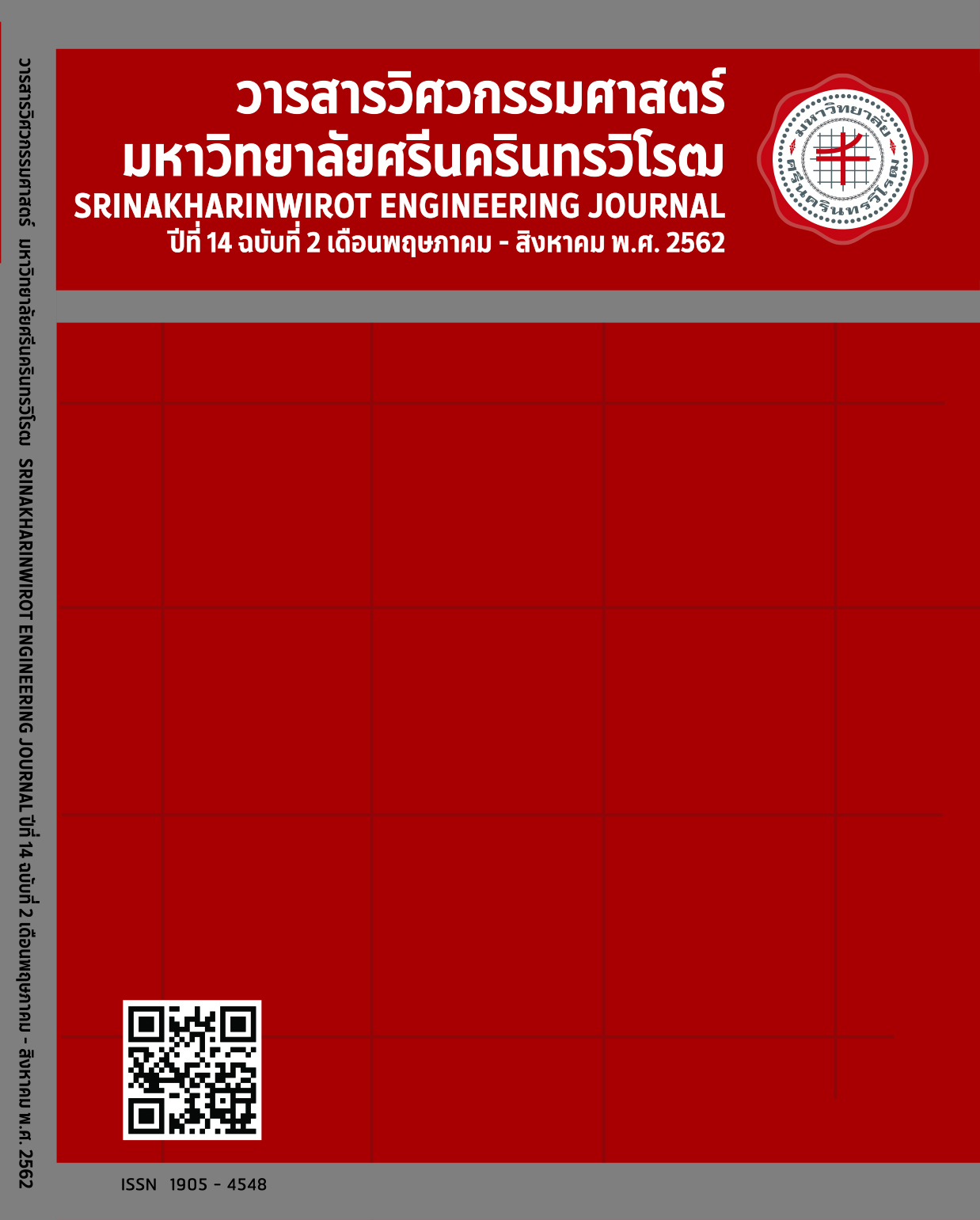Harmonic Elimination using Active Power Filter for Non-Sinusoidal Voltage Source System
Main Article Content
Abstract
This paper presents harmonic elimination using active power filter for non-sinusoidal voltage source system. The instantaneous power theory (PQ) with positive sequence voltage detector (PSVD) is used for harmonic detection to calculate the reference current. The PI–controller is applied for compensating current control and DC bus voltage control. This controller is used with PWM switching technique. Moreover, the Matlab Simulink is applied for simulation in the paper. The simulation results show that the active power filter with PI–controller can provide the good performance to eliminate the harmonic for all loads in non-sinusoidal voltage source system. In the paper, the performance index is of source current after compensation. In addition, the after compensation can follow the IEEE Std.519 – 2014 and IEEE std.1459 – 2010.
Article Details
Copyright belongs to Srinakharinwirot University Engineering Journal
References
[2] B. M. Elham, L. W. Clarence, and A. G. Adly, “A Harmonic Analysis of the Induction watthour Meter's Registration Error,” IEEE Transaction on Power Delivery, vol. 7, pp. 1080-1088, July 1992.
[3] D. E. Rice, “Adjustable Speed Drive and Power Rectifier Harmonics – Their Effect on Power Systems Components,” IEEE Transaction on Industrial, vol. 22, pp. 161-177, Jan 1986.
[4] V. E. Wagner, “Effects of Harmonics on Equipment,” IEEE Transaction on Power Delivery, vol. 8, no. 2, pp. 672-680, Apr 1993.
[5] J. M. Ho, and C. C. Liu, “The Effects of Harmonics on Differential Relay for a Transformer,” IEE International Conference and Exhibition on Electricity Distribution (CIRED), Amsterdam, Netherlands, 2001.
[6] B. Singh, K. A. Haddad, and A. Chandra, “A Review of Active Filters for Power Quality Improvement,” IEEE Transaction on Industrial Electronics, vol. 46, no. 5, pp. 960-971, Oct 1999.
[7] C. A. Quinn, and N. Mohan, “Active Filtering of Harmonic Currents in Three-phase, Four-Wire Systems with Three-phase and Single-phase Non-Linear Loads,” IEEE-APEC’92 Appl. Power Electronics Conference, 1992, pp. 829-836.
[8] H. Akagi, “New Trends in Active Filters,” In EPE’95-European Conference Power Electronics Appl., Sevilla, Spain, 1995, pp. 17-26.
[9] H. Akagi, H. Fujita, and K. Wada, “A Shunt Active Filter Based on Voltage Detection for Harmonic Termination of Radial Power Distribution Line,” IEEE Transactions on Industrial Applications, vol. 35, no. 3, pp. 638-645, May 1999.
[10] H. Akagi, Y. Kanazawa, and A. Nabae, “Instantaneous Reactive Power Compensators Comprising Switching Devices without Energy Storage Components,” IEEE Transaction on Industry Applications, vol. IA-20, no. 3, pp. 625-630, May 1984.
[11] M. Takeda, K. Ikeda, A. Teramoto, and T. Aritsuka, “Harmonic Current and Reactive power compensation with an Active filter,” 19th Annual IEEE Power Electronics Specialists Conference, Kyoto, Japan, 1988, pp. 1174-1179.
[12] G. W. Chang, S. K. Chen, and M. Chu, “An Efficient a–b–c Reference Frame-Based Compensation Strategy for Three-Phase Active Power Filter Control,” Electric Power Systems Research, vol. 60, pp. 161-166, Jan 2002.
[13] H. Akagi, E. H. Watanabe, and M. Aredes, Instantaneous Power Theory and Applications to Power Conditioning. John Wiley & Sons, 2007.
[14] O. Abdelkhalek, and C. Benachaiba, “Sensitivity Assessment of PQ Theory and Synchronous Detection Identification Methods of Current Harmonics Under Non-Sinnusoidal Condition for Shunt Active Power Filter,” Journal of Electrical & Electronics Engineering, vol. 9, no. 1, pp. 801-807, 2009.
[15] H. Akagi, “New trends in active filters for power conditioning,” IEEE Transaction on Industry Applications, vol. 32, no. 6, pp. 1312-1322, Nov 1984.
[16] Y. Hayachi, N. Sato, and K. Takahashi, “A Novel Control of a Current Source Active Filter for AC Power System Harmonic Compensation,” IEEE Transaction on Industry Applications, vol. 27, no. 2, pp. 380-384, Aug 2002.
[17] A. Zouidi, F. Fnaiech, and K. Al-Haddad, “Voltage source Inverter Based three-phase shunt active Power Filter: Topology, Modeling and Control Strategies,” IEEE-ISIE International Symposium on Industrial Electronics, pp. 785-790, 2006.
[18] M. Routimo, M. Salo, and H. Tuusa, “Comparison of Voltage-Source and Current-SourceShunt Active Power Filters.” IEEE Transactions on Power Electronics, vol. 22, no. 2, pp. 636-643, 2007.
[19] P. Santiprapan, K-L. Areerak, and K-N. Areerak, “Mathematical Model and Control Strategy on DQ Frame for Shunt Active Power Filters,” World Academy of Science Engineering and Technology, vol. 60, pp. 353-361, 2001.
[20] T. Narongrit, K-L. Areerak, and K-N. Areerak, “Optimal Design of Shunt Active Power Filters Using a Particle Swarm Optimization,” International Review on Modelling & Simulations, vol. 4, pp. 2871-2878, 2011.
[21] T. Narongrit, K-L. Areerak, and K-N. Areerak, “Adaptive Fuzzy Control for Shunt Active Power Filters,” Electric Power Components and Systems, vol. 44, no. 6, pp. 646-657, 2016.
[22] S. Rahmani, N. Mendalek, and K. Al-Haddad, “Experimental Design of a Nonlinear Control Technique for Three-Phase Shunt Active Power Filter,” IEEE Transactions on Industrial Electronics, vol. 57, pp. 3364-3375, Jan 2010.
[23] H. Akagi, Y. Kanazawa, and A. Nabae, “Generalized theory of the instantaneous reactive power in three-phase circuits,” In Proc. Int. Power Electronics Conference, 1983, pp. 1375-1386.
[24] T. Thomas, K. Haddad, G. Joos, and A. Jaafari, “Design and Performance of Active Power Filters,” IEEE Industry Application Magazine, vol. 4, pp. 38-46, Sep 1998.
[25] D. M. E. Ingram, and S. D. Round, “A Novel Digital Hysteresis Current Controller for an Active Power Filter,” International Conference on Power Electronics and Drive Systems, Singapore, 1997, vol. 2, pp. 744-749.
[26] J. Eakburanawat, P. Darapong, U. Yangyuen, and S. Po-ngam, “A Simple Control Scheme of Single Phase Universal Active Filter for Power Quality Improvement,” In 2004 IEEE Region 10 Conference TENCON, Chiang Mai, Thailand, 2004, pp. 248-251.


